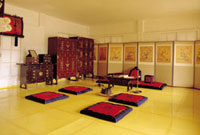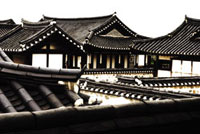
Ondol: In modern usage it refers to any type of underfloor heating of a room that follows the traditional way of eating and sleeping on the floor.
Hanok, traditional Korean houses, remained relatively unchanged from the Three Kingdoms period through the late Joseon Dynasty (1392-1910).
Ondol, a unique Korean underfloor heating system, was first used in the north. Smoke and heat generated from the low-lying kitchen stoves were channeled through flues built under floors.
In the warmer south, ondol was used together with wooden floors. The major materials of traditional houses were clay and wood. Giwa, or black-grooved roof tiles, were made of earth, usually red clay. Today, the Presidential mansion is called Cheong Wa Dae, or the Blue House, for the blue tiles used for its roof.
Hanok were built without using any nails but rather assembled with wooden pegs. Upper-class houses consisted of a number of separate structures, one for the accommodation of women and children, one for the men of the family and their guests, and another for servants, all enclosed within a wall. A family ancestral shrine was built behind the house. A lotus pond was sometimes created in front of the house outside the wall.

Namsangol Traditional Village in downtown Seoul
The form of the houses differed from the colder north to the warmer south. Simple houses with a rectangular floor and a kitchen and a room on either side developed into an L-shaped house in the south. Hanok later became U- or square-shaped centered around a courtyard.
From the late 1960s, Korea's housing pattern began to change rapidly with the construction of Western-style apartment buildings. High-rise apartments have mushroomed all over the country since the 1970s but the ondol system has remained popular with heated water pipes taking the place of smoke flues under the floor.